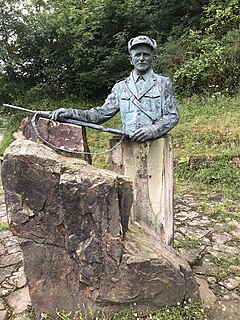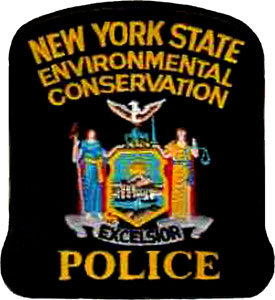Department Overview
Structure
Michigan Conservation Officers fall under the Law Enforcement Division of the Michigan Department of Natural Resources. Some states including Oregon and Alaska include environmental law enforcement under the Department of State Police. This allows resources to be combined and saves the states money by eliminating duplicate services. Combining the two departments also has some disadvantages. Most states don't combine the two departments. The Law Enforcement Division is broken down into a number of subsections. The subsections include:
- Field Operations
- Environmental Investigations
- Emergency Management
- Great Lakes Enforcement Unit (GLEU)
- Special Investigations Unit (SIU)
- Recreational Safety Programs
- Employment, Training, & Legal
(Note, Wildlife Resource Protection unit became individual Investigative Unit [SIU] and Commercial Fish unit [GLEU])
Personnel
The Law Enforcement Division of the Michigan Department of Natural Resources has approximately 250 officers. [3]
They are represented in collective bargaining by a union, the Michigan State Employees Association. [4] The last time the Law Enforcement Division (LED) of the Michigan Department of Natural Resources held a recruit academy was 2018. The academy concluded December 2018. At that time they added 24 new conservation officers. [5]
Rank structure
(Note, Detective and Corporal are the same payscale,)
Budget
| Fiscal Year | DNR Budget | Law Enforcement Budget | Pct. of DNR Budget |
|---|
| 2008–2009 | 289,400,000.00 | 34,728,000.00 | 12% |
| 2009–2010 | 282,300,000.00 | 28,230,000.00 | 10% [6] |
| 2010-2011 | 300,900,000.00 | 30,090,000.00 | 10% [7] |
| 2011-2012 | 304,300,000.00 | 30,430,000.00 | 10% |
| 2012-2013 | 321,100,000.00 | 32,100,000.00 | 10% [8] |
| 2013-2014 | 328,573,300.00 | 34,387,200.00 | 11% [8] |
| 2014-2015 | 356,121,000.00 | 35,612,000.00 | 10% [8] |
| 2015-2016 | 404,000,000.00 | 40,400,000.00 | 10% [9] |
| 2016-2017 | | | |
| 2017-2018 | | | |
| 2018-2019 | | | |
Transportation
Michigan conservation officers use the Chevrolet Silverado and Chevrolet Tahoe as patrol vehicles. They also use patrol boats, both motorized and human-powered, that range in size when they patrol the Great Lakes, inland lakes, rivers, and streams. Other vehicles used include snowmobiles and All Terrain Vehicles (ATVs).
Training
In January 2014 the MDNR Law Enforcement Division commenced its first academy since 2007 with 31 recruits. This ended a nearly 7-year gap in recruit schools. During the gap, caused by budgetary issues, once an individual was selected for the position of Conservation Officer and the individual was not certified by MCOLES the MDNR paid the individual to complete the required MCOLES Academy. They then would complete the MDNR Environmental Law Enforcement courses. If the individual was MCOLES certified the individual would go through training courses focusing on Environmental Law Enforcement.
Once selected by the Department of Natural Resources through a rigorous selection process the recruits go through an intense 22-week live in training period. The live-in training is held at the Michigan State Police training facility in Lansing. Once completed, the recruits are then fully commissioned conservation officers. After the training, the new officers will be assigned a field-training officer for 18 weeks at a variety of locations around the state. Once the probation period is completed, the officers will be assigned to one of the 83 counties in Michigan. Michigan Conservation Officers are certified by the Michigan Commission on Law Enforcement Standards or MCOLES.
Other
MDNR Report All Poaching Hotline RAP 1-800-292-7800
The Virginia Department of Wildlife Resources is a department of the government of the U.S. state of Virginia that regulates wildlife conservation.

The Georgia Department of Natural Resources (DNR) is an administrative agency of the U.S. state of Georgia. The agency has statewide responsibilities for managing and conserving Georgia’s natural, cultural, and historical resources, and has six divisions:

The Minnesota Department of Natural Resources, or Minnesota DNR, is the agency of the U.S. state of Minnesota charged with conserving and managing the state's natural resources. The agency maintains areas such as state parks, state forests, recreational trails, and recreation areas as well as managing minerals, wildlife, and forestry throughout the state. The agency is divided into six divisions - Ecological & Water Resources, Enforcement, Fish & Wildlife, Forestry, Lands & Minerals, and Parks & Trails.

The Wisconsin Department of Natural Resources (WDNR) is a government agency of the U.S. state of Wisconsin charged with conserving and managing Wisconsin's natural resources. The Wisconsin Natural Resources Board has the authority to set policy for the WDNR. The WDNR is led by the Secretary, who is appointed by the Governor of Wisconsin. The WDNR develops regulations and guidance in accordance with laws passed by the Wisconsin Legislature. It administers wildlife, fish, forests, endangered resources, air, water, waste, and other issues related to natural resources. The central office of the WDNR is located in downtown Madison, near the state capitol.

The Michigan Department of Natural Resources (DNR) is the agency of the state of Michigan charged with maintaining natural resources such as state parks, state forests, and recreation areas. It is governed by a director appointed by the Governor and accepted by the Natural Resources Commission. Currently the Director is Daniel Eichinger. The DNR has about 1,400 permanent employees, and over 1,600 seasonal employees.

The New York State Department of Environmental Conservation is a department of New York state government. The department guides and regulates the conservation, improvement, and protection of New York's natural resources; manages Forest Preserve lands in the Adirondack and Catskill parks, state forest lands, and wildlife management areas; regulates sport fishing, hunting and trapping; and enforces the state's environmental laws and regulations. Its regulations are compiled in Title 6 of the New York Codes, Rules and Regulations. It was founded in 1970, replacing the Conservation Department. and is headed by Basil Seggos.
The Pennsylvania Department of Conservation and Natural Resources (DCNR), established on July 1, 1995, is the agency in the U.S. State of Pennsylvania responsible for maintaining and preserving the state's 121 state parks and 20 state forests; providing information on the state's natural resources; and working with communities to benefit local recreation and natural areas. The agency has its headquarters in the Rachel Carson State Office Building in Harrisburg.

The California Department of Fish and Wildlife (CDFW), formerly known as the California Department of Fish and Game (CDFG), is a state agency under the California Natural Resources Agency. The Department of Fish and Wildlife manages and protects the state's wildlife, wildflowers, trees, mushrooms, algae (kelp) and native habitats (ecosystems). The department is responsible for regulatory enforcement and management of related recreational, commercial, scientific, and educational uses. The department also prevents illegal poaching.

The Florida Fish and Wildlife Conservation Commission (FWC) is a Florida government agency founded in 1999 and headquartered in Tallahassee. It manages and regulates the state's fish and wildlife resources, and enforces related laws. Officers are managers, researchers, and support personnel, and perform law enforcement in the course of their duties.
The Iowa Department of Natural Resources is a department/agency of the U.S. state of Iowa formed in 1986, charged with maintaining state parks and forests, protecting the environment of Iowa, and managing energy, fish, wildlife, land resources, and water resources of Iowa.

A conservation officer is a law enforcement officer who protects wildlife and the environment. A conservation officer may also be referred to as an environmental technician or technologist, game warden, forest ranger, forest watcher, forest guard, forester, gamekeeper, investigator, wilderness officer, wildlife officer, or wildlife trooper.
The Alabama Department of Conservation and Natural Resources (ADCNR) is the state agency responsible for the conservation and management of Alabama's natural resources including state parks, state lands, wildlife and aquatic resources. ADCNR also issues hunting and fishing licenses for the state. The department promotes wise stewardship and enjoyment of the state's natural resources through five divisions: Marine Resources, State Lands, State Parks and Wildlife and Freshwater Fisheries. Supporting those divisions are seven support sections: Accounting, Diversity and Recruiting, Engineering, Information and Education, Information Technology, Legal, and Personnel and Payroll.
The Maryland Department of Natural Resources (DNR) is a government agency in the state of Maryland charged with maintaining natural resources including state parks, public lands, state forests, state waterways, wildlife, and recreation areas. Its headquarters is in Annapolis.

The Maryland Natural Resources Police (NRP) is the law enforcement arm of the Maryland Department of Natural Resources (DNR), tasked with enforcing laws on the state's public lands and waterways, protecting fish and wildlife, and leading search and rescue efforts. The Natural Resources Police is also the state's maritime homeland security agency.

The New York State Department of Environmental Conservation Police, is the law enforcement agency of the New York State Department of Environmental Conservation, Division of Law Enforcement. NYS Environmental Conservation Officers are New York State police officers. As the uniformed law enforcement representatives of the Department of Environmental Conservation, environmental conservation police are responsible for the enforcement of the environmental laws and regulations of New York and for the detection and investigation of suspected violations.

The North American Game Warden Museum is a museum in the International Peace Garden on the Canada–United States international border between the Canadian province of Manitoba and the U.S. state of North Dakota. The museum is located on the American side of the border. Initially founded on a temporary basis at the International Peace Garden in the 1990s, it became a permanent museum in 2005.
The New Jersey State Park Police patrol and protect the State's 54 parks, forests, recreation areas and 130 natural trust preserves which encompass more than 448,000 acres (1,810 km2) and are visited by more than 18 million people each year. Their motto is "Protecting New Jersey's Treasures and the people who visit them." All State Park Police Officers are sworn State Law Enforcement Officers who are PTC certified. Officers have statewide jurisdiction, carry weapons and have all of the arrest and law enforcement powers of any police officer in the state. They are dedicated to safeguarding New Jersey's resources 24 hours a day through the prevention of crime, apprehension of criminals, enforcement of criminal and motor vehicle laws of the state, and enforcement of park regulations. State Park Police respond to public safety emergencies and environmental emergencies as well as provide mutual aid assistance to municipal, county, state and federal law enforcement agencies. They use various methods of patrol, including foot, bike, boat, ATV, and motor patrol.

The Montana Department of Fish, Wildlife and Parks (MFWP) is a government agency in the executive branch state of Montana in the United States with responsibility for protecting sustainable fish, wildlife, and state-owned park resources in Montana for the purpose of providing recreational activities. The agency engages in law enforcement activities to enforce laws and regulations regarding fish, wildlife, and state parks, and encourages safe recreational use of these resources.

The Massachusetts Environmental Police is a Massachusetts, US, state government law enforcement agency, which is the primary enforcement agency of Massachusetts's boating and recreation vehicle laws and regulations and is responsible for registering boats, off-highway vehicles and snowmobiles in Massachusetts. The agency is also responsible for the enforcement of fish and game laws, including commercial and recreational harvesting of the living marine resources along the state's coastline.


















